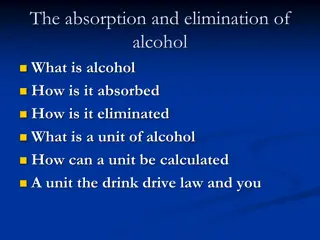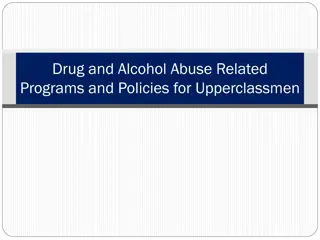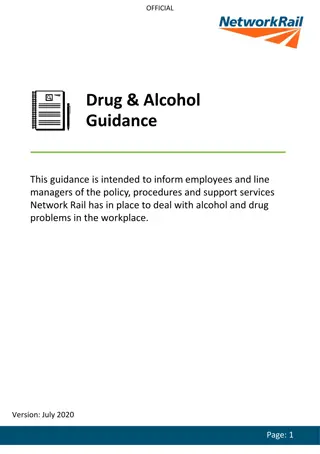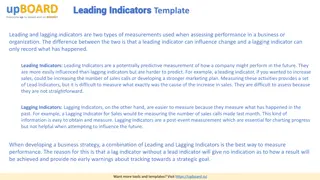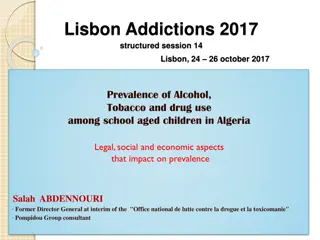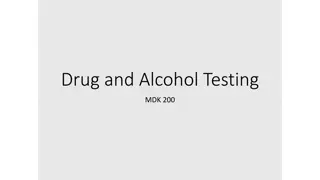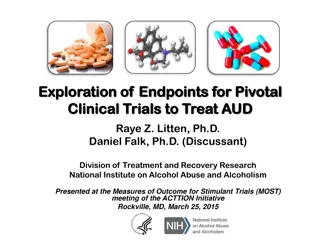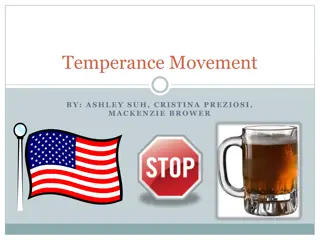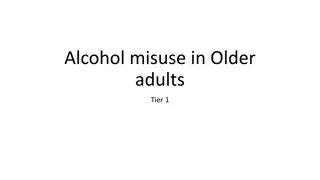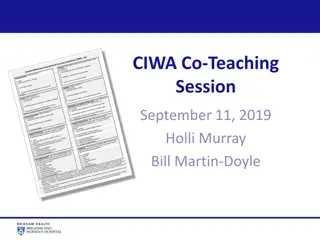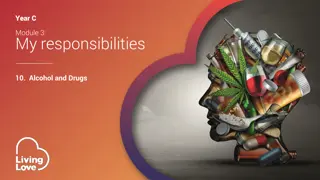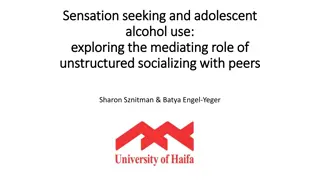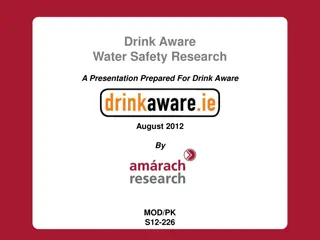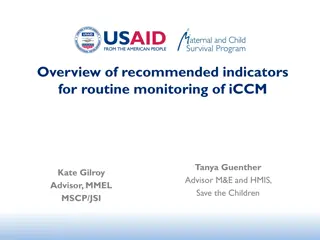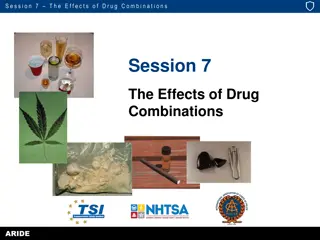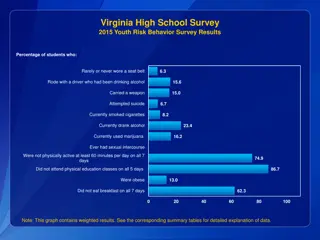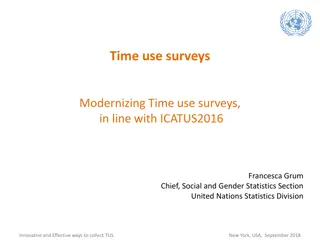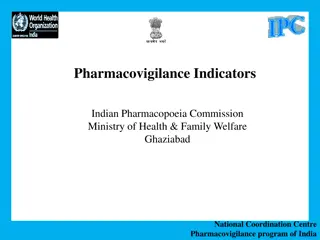Different Modes of Data Collection: Impact on Alcohol and Drug Consumption Indicators
This study explores how data collection methods impact prevalence rates of alcohol and drug consumption indicators among the general adult population. Conducted in Lisbon and Oporto, the research compared results from CATI, CAWI, and CAPI surveys. Findings revealed differences in sociodemographic characteristics and alcohol consumption patterns based on the interview technique employed.
Download Presentation

Please find below an Image/Link to download the presentation.
The content on the website is provided AS IS for your information and personal use only. It may not be sold, licensed, or shared on other websites without obtaining consent from the author. Download presentation by click this link. If you encounter any issues during the download, it is possible that the publisher has removed the file from their server.
E N D
Presentation Transcript
DIFFERENT MODES OF DATA COLLECTION, DIFFERENT RESULTS? Clara Vital, Casimiro Balsa & Cl udia Urbano FCSH, Universidade Nova de Lisboa Authors discloseany conflictof interest.
National Surveys on Drugs are important data sources for empirical research in public health. However, thediversity ofmethods applied, makeitdifficult to compare results acrosssurveys, time, orcountries Background Theaimofthisstudy isto explore whether theprevalencerates of alcoholanddrugs consumptionindicatorsamonggeneral adult populationdiffer whenusingCATI, CAWI orCAPI.
Our study wasconductedin conjunctionwith theRARHA - ReducingAlcoholRelatedHarm survey weproceeded to a selectionof24 questions (correspondingto 51 variables) from whichwe defined a commonquestionnaireto compare different survey techniques. Wehavelimited the applicationofthequestionnaire to theregionofLisbonand Oporto MethodsI Thesewere the sizesamples by mode: 589 telephone interviews were carriedout in theCATI system; 622 online interviews, in theCAWI system (Panelusers from INTERCAMPUS); and, 338 personalinterviews, in theCAPI system.
The variables considered allow to compare the results obtained by each of the interview techniques at the following levels: prevalence rates of alcohol consumption; a test of alcohol abuse (RAPS); MethodsII prevalence rates of illicit drugs, sociodemographic. For our initial proposes, we analyzed the data from the three surveys without weighting.
Sociodemographic data Respondentspresented slightlydifferent sociodemographic characteristicsdepending onthe method ofinquiry Gender ratio is similar in CAPI andCATI, witha more balanced distribution thanin CAWI CAWI sample hasa youngersample comparedto CATI andCAPI ResultsI CATI andCAWI samples havea higherpercentageof singles, comparedwith theCAPI sample Sample respondents in CATI andCAWI hadhigherpercentagesof highereducationthanthoseatCAPI Itis amongtherespondents in CAWI thatwefinda greater number ofworkers
Alcohol consumption data AmongCAPI respondents, wefound thehighestpercentage of absenteeismin alcoholconsumption, compared to those interviewed in CATI andmainlyin CAWI Respondentsin theCAWI sample are more weekend drinkers, reportinga consumptionof1 to 2 days per week. Also in CATI there is a significantpercentage ofusers witha consumption frequency of1 to 2 days per week in the last12 months, compared to thoseinterviewed in CAPI. ResultsII Thesample respondents in CAPI andCATI presented dailyintakes ofalcoholicbeverages higherthanthosesampledin CAWI. CAWI sample presents the higherpercentageofaffirmative answersto the 4 items that composethe RAPS test. In theCAPI andCATI samples the percentagesappearbalanced.
Drugsconsumption data It isamongCAPI respondentsthattheprevalenceofillicit psychoactivesubstanceuse is lower. Notonlyare they less likely to consume, as they are theones thatconsumeda minornumber ofsubstances, andthosewhoindicatedthatthey were consumers, they consumed them less often. ResultsIII Itis in CAWI, wherethe distanceto the interviewer isgreater, that wefound thehighestprevalenceofconsumption, the highest number ofsubstances consumed andin a greater number of times.
Lifetime prevalence ofany drug, cannabis and cocaine in the 3 diferente samples 40 35.9 35 35 30 27 26.3 25 ResultsIV 20 15 8.8 8.5 10 5.8 4.1 5 1.6 0 Any drug Cannabis Cocaine CAPI CATI CAWI
Strength The respondentes were surveyed atthe sametime periodandin the sameregions Limitations Strengthand Limitations Thesamples are restricted to the regionsofLisbonandOporto Thesizeofthesamples Thereduced number ofquestions used in the questionnaires. Furthermore, in theCAPI questionnaire, thequestions were part ofa largerquestionnaire(therefore oflongerduration) and appearedin a different order ofpresentation.
Weknowthatmodes ofdata collectiondiffer in a number ofways, includingthe method ofcontactingrespondents, the means by whichthequestionnaireisdelivered to respondents, andthe way questions are administered. Thesemay haveaneffect onthe orientationofthe responses andonthequalityofthe data collected. In anymode ofadministeringthequestionnaires, there are many potentialinfluences ontheresponses. Thesedifferences, at different levels, may makeitdifficult to isolatetheeffects ofeach ofthe modes ofdata collectiononthequalityofthe data obtained. Therefore, more than just using different modesof data collection, what seems to have effects on the results is rather a combination of factors. ConclusionsI
Notforgettingthatthere are limitations, broughtabout by the type ofsurvey databases thatresearchers haveavailable, the possibilitiesofchoosingthedifferent methods ofquestionnaire administration, theconclusionthatcan be drawnfrom the analysis ofthe particular advantagesanddisadvantagesofeachmethod, is thatthisoptioncan notbe made withouttakingintoaccountthe natureofthe informationthat onewillorwillnotloseifonechose for the othermethods. ConclutionsII The findings of this study indicate that prevalence rates obtained from general population surveys can vary with the mode of data collection.
Balsa etal(2003). Inqu rito Nacional ao Consumo de Subst ncias Psicoativas na Popula o Portuguesa 2001. Cole o Estudos-Universidades. Lisboa: Instituto da Droga e da Toxicodepend ncia. Christian L. M. (2007). How Mixed-Mode Surveys are Transforming Social Research: The Influence of Survey Mode on Measurement in web and Telephone Surveys. Washington State University. De Leeuw, E. (2005). To Mix or Not to Mix Data Collection Modes in Surveys, Journal of Official Statistics, 21(2), 233 255. De Leeuw, E. (2008). Choosing the method of data collection. In International Handbook of Survey Methodology, EAM series. Edited by De LeeuwE, HoxJJ, Dillman D. New York: Taylor & Francis, PrychologyPress,113 135. De Leeuw, E., HoxJ. J. (2011). Internet surveys as part of a mixed-mode design. In Social and Behavioral Research and the Internet. Edited by Das M, Ester P, KaczmirekL. New York, London: Routledge Taylor & Francis Group, 9. Dillman, D., Smyth J. D., Christian L. M. (2009). Internet, mail, and mixed-mode surveys: the tailored design method. Hoboken, New Jersey: John Wiley & Sons, Inc. Duffy, Bobby, Smith, Kate, Terhanian, George e Bremer, John (2005). Comparing data from online and face-to-face surveys. International Journal of Market Research, Vol. 47, N. 6, pp. 615-639. Bibliography Floyd, J. e Fowler, J. R. (2002). Survey Research Methods, 3rd Edition, London: Sage. Hoebelet al.(2014) Mode differences in a mixed-mode health interview survey among adults. ArchivesofPublicHealth, 72:46, pp. 1-12. INE (2012). Inqu rito s Despesas das Fam lias 2010-2011. Lisboa: Instituto Nacional de Estat stica, I.P Kraus, Florian e Steiner, Viktor (1998). Modelling Heaping Effects in Unemployment Duration Models With an Application to Retrospective Event Data in the German Socio-Economic Panel, Journal of Economics and Statistics, 217(5), 550-573. Krosnick, J. A. (1991). Response strategies for coping with the cognitive demands of attitude measures in surveys. Applied cognitive psychology, 5(3), 213 236. Krosnick, J. A. e Alwin, D. F. (1987). An Evaluation of a Cognitive Theory of Response-Order Effects in Survey Measurement. Public Opinion Quarterly, 51(2), 201 219. Macer, T. (2005). Weaving, not drowning: an update on take-up and best practices in mixed-and multi-mode research. 2005. [www.meaning.uk.com/resources/ articles_papers/files/spss_directions_2005.pps] Vannette, David L. e Krosnick, Jon A. (2013). Answering Questions: A Comparison of Survey Satisficing and Mindlessness. E.U.A.: Stanford University. Winter, Mariellede, Cohen, Peter e Langemijer, Marieke(1999). Project to co-ordinate a methodological study to compare the prevalence of self-reported drug use in general population surveys, EMCDDA project CT.97. EP.02. Lisboa: EMCDDA
Thank you for your attention! claravital@fcsh.unl.pt cm.balsa@fcsh.unl.pt Claudia.urbano@fcsh.unl.pt


